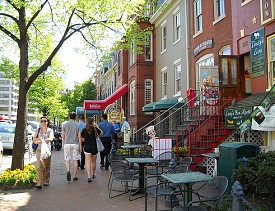Choosing a Sustainable House to Rent or Buy
 Whether looking to buy or rent, the housing search has only become more complicated in the current market. Prospective homebuyers and renters are coming up with a whole new list of criteria for their future place. Sure, granite counters and central air conditioning are still highly coveted features, but in this economy, people consider the sustainability of their new home more so than ever. Comes the New Urbanism movement, a movement of builders and city planners to promote walkable, sustainable living environments. Transit-oriented development, local and sustainable building materials and proximity to shopping and schools are all features of a New Urbanism community.
Whether looking to buy or rent, the housing search has only become more complicated in the current market. Prospective homebuyers and renters are coming up with a whole new list of criteria for their future place. Sure, granite counters and central air conditioning are still highly coveted features, but in this economy, people consider the sustainability of their new home more so than ever. Comes the New Urbanism movement, a movement of builders and city planners to promote walkable, sustainable living environments. Transit-oriented development, local and sustainable building materials and proximity to shopping and schools are all features of a New Urbanism community.
Here is a list of things to look for in your digs to determine whether or not it’s a sustainable decision.
1. Can you walk to the supermarket?
This is the most important question to ask, since trips to the supermarket are frequent. Relying on personal transportation such as cars, or even public transportation, creates a dependency on outside sources, most significantly fuel for gasoline. Dependency is not sustainable. If you can walk to the grocery store from your home, then you are in good shape. Even in "driving cities" like Los Angeles, remodeling an older house in a walkable neighborhood (like Silver Lake, for examplem in Los Angeles) makes it possible to be less dependent on a car.
2. Is driving the only way of getting to town?
Proximity to public transportation is both smart for your wallet and smart for the environment. If you have to walk more than 10 minutes from your new home to get to public transportation such as bus, subway or train, then you might want to reconsider your choice of residence. Relying on your own car to get places means relying on foreign oil and on your wallet to get around.
3. Is your new home affordable?
Many financial advisors say you should not spend more than 35% of your gross income on rent. Others say no more than 25%. If you are spending more than that, your housing is simply not sustainable.
4. Are there parks and playgrounds nearby?
Whether or not you have kids, you will most probably find yourself gravitating to the local green space, either to just sit on a bench or to have a full on picnic. Local parks and playgrounds are essential for both entertainment as well as general oxygenation in providing fresh air. You shouldn’t have to get in the car or on a bus to find the closest park. A sustainable home has one down the street!
Looking for a Pro? Call us (866) 441-6648

Remodeling Average Costs
Remodeling Contractors Experiences

The Right Landscaper Can Change A Yard From Terrible To Terrific

Rock Landscaping Adds Curb Appeal To An Arizona Home



